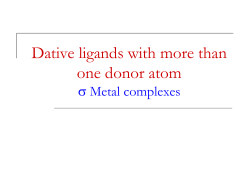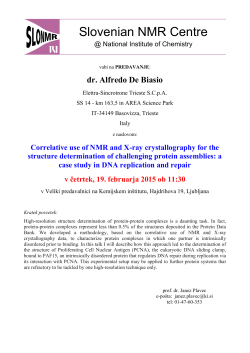
Poster - of Kenneth Weiss
IA*: An Adjacency-Based Representation for
Non-Manifold Simplicial Shapes in Arbitrary Dimensions
David Canino ⋅ Leila De Floriani ⋅ Kenneth Weiss
canino@disi.unige.it
BACKGROUND
deflo@disi.unige.it
kweiss@cs.umd.edu
CONTRIBUTION
Need to represent and manipulate 2D, 3D and
higher dimensional simplicial complexes describing
multi-dimensional shapes with complex topology
Generalized digital shapes:
are discretized through simplicial complexes
over an arbitrary underlying domain
can contain non-manifold singularities
REPRESENTATION
The Generalized Indexed data structure
with Adjacencies (IA*):
dimension-independent adjacency-based
data structure for general shapes
agnostic about embedding of the input
shape in the underlying space
encodes only vertices and top simplices
(simplices not on the boundary of other simplices)
can contain non-regular parts
of different dimensionalities
optimal retrieval of all topological relations
scalable with respect to manifold case
supports shape editing operations
more compact than state of the art
dimension-independent incidence-based
Incidence Graph (IG) [Ede87] and
Incidence Simplicial (IS) [DFHPC10]
Manifold shape
Non-manifold shape with parts
of different dimensionalities
STORAGE COSTS
Incidence-based data structures (IG and IS)
Dimension-specific adjacency-based data
structures (TS in 2D and NMIA in 3D)
IG
IS
TS
Armchair
127K 101K 69.4K
NMIA
IA*
- 69.2K
Balance
96K
76K 51.9K
- 51.9K
Carter
95K
75K
53K
-
52K
220K 174K
121K
-
120K
Chandelier
For each vertex v:
R*0,1(v): all top 1-simplices incident in v
R*0,p(v): one top p-simplex (with p>1) for each
(p-1)-connected component of the link of v
For each top p-simplex σ:
R p,0(σ): all vertices in the boundary of σ
R*p,p(σ): all top p-simplices adjacent to σ
along a (p-1)-face of σ
Key observation
Encode top p-simplices in non-manifold
singularities along (p-1)-faces of σ
collectively through R*p-1,p(σ) relation
IA* reverts to IA data structure [PBCF93]
when presented with manifold shape
TOPOLOGICAL QUERIES
We compared storage costs of IA* with
Model
dimension-specific adjacency-based
Triangle Segment (TS) [DFMPS04] in 2D
Non-manifold Incidence with Adjacency
(NMIA) [DFMPS04] in 3D
Encode only vertices and top simplices
Robot
80K
63K
46K
- 44.9K
Ballon
44K
33K
-
Flasks
104K
74K
-
Gargoyle
271K 193K
-
83K
Rings
231K 164K
-
68K 67.6K
Teapot
219K 162K
-
18K
18K
32 31.8K
84.7K
83K
84K
Storage costs are expressed in terms of the number of pointers.
Over a testbed of 62 manifold, non-regular and
non-manifold shapes in 2D and 3D,
IA* is the most compact data structures:
1.5 times smaller than the IS for 2D models
1.8 times smaller than the IG for 2D models
2.2 times smaller than the IS for 3D models
3.2 times smaller than the IG for 3D models
5% smaller than the TS for 2D models
3% smaller than the NMIA for 3D models
Boundary relations for p-simplex σ are retrieved by
generating faces of σ, requiring constant time:
IA* is 15% faster than IG and IS
Co-boundary relations of type R0,q(v) are retrieved
with respect to top simplices incident in v, requiring
time linear in the number of top simplices in the star
of vertex v:
IA* is 20% faster than IG
and 30% faster than IS for 2D models
IA* is 35% faster than IG
and 62% faster than IS for 3D models
Co-boundary relations of type Rp,q(σ), with p≠0,
are based on the retrieval of the R0,q(v) relation for
a vertex v of simplex σ, requiring time linear in the
number of top simplexes incident in v:
IA* is 15% slower than IG for R1,q
IA* is 11% slower than IS for R1,q
Adjacency relations for a simplex σ are retrieved by
combining boundary and co-boundary relations and
require time linear in the number of top simplices
incident in one vertex of σ.
R*0,1(v)
R*0,2(v)
R*0,3(v)
R*2,2(f1)
= {w},
= {f1, f5},
= {t1}
= R*1,2(e)
= { f1, f2, f3, f4 }
REFERENCES
L. De Floriani, A. Hui: A scalable data structure for three dimensional non-manifold objects,
Symposium on Geometry Processing, 2003.
L. De Floriani, A.Hui, D. Panozzo, D. Canino: A dimension-independent data structure for simplicial complexes,
International Meshing Roundtable, 2010.
L. De Floriani, P. Magillo, E. Puppo, D. Sobrero: A multi-resolution topological representation for non-manifold meshes,
CAD Journal, 2004.
H. Edelsbrunner: Algorithms in Combinatorial Geometry, Springer, 1987.
A. Paoluzzi, F. Bernardini, C. Cattani, V. Ferrucci: Dimension-independent modeling with simplicial complexes,
ACM Transactions on Graphics, 1993.
© Copyright 2025

![arXiv:1412.5920v1 [math.CO] 18 Dec 2014](http://cdn1.abcdocz.com/store/data/000655004_1-4d9182a992c1ad22d29aa59e1c27fc73-250x500.png)








